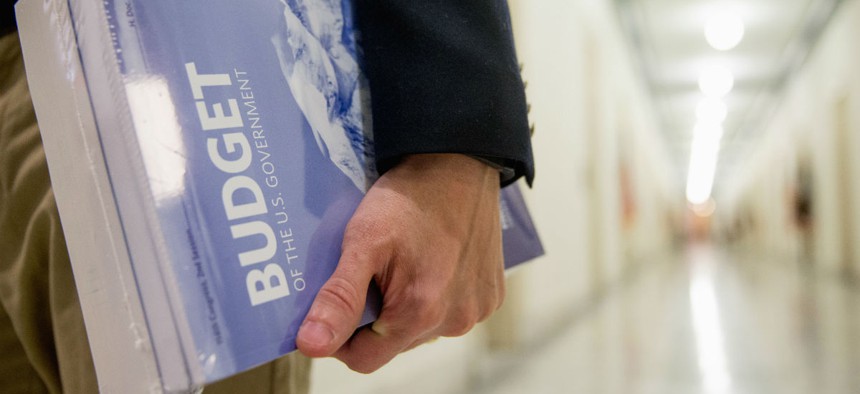
Andrew Harnik/AP
Obama’s Budget Touts Progress Within Federal Workforce, but Offers it Nothing New
White House again calls for overhaul of outdated federal civil service.
President Obama in his fiscal 2017 budget unveiled Tuesday touted his administration’s improvement of the performance and morale of the federal workforce, but offered very little in the way of new initiatives to build upon those efforts.
The blueprint meticulously detailed every federal employee program undertaken in the last several years, including those aimed at senior executives, improving hiring and increasing the use of data metrics and analysis. The White House highlighted federal employees’ role in opening military combat positions to women, negotiating “complex trade and political treaties,” calculating the return on investment at colleges and universities and improving the country’s overall fiscal outlook as the group’s major accomplishments in 2015.
“Federal employees are our neighbors, civic leaders and taxpayers,” the White House wrote in the budget. “The federal government is the nation’s largest employer of doctors and employs individuals responsible for protecting our natural resources, waterways and historic landmarks, providing grants for research, housing, and education. Federal employees are also called into action in the event of a disaster, whether that means stopping Ebola or out-of-control forest fires.”
Most of the specifics Obama and his team laid out in a section of the budget called “Strengthening the Federal Workforce” rehashed old proposals and recapped what the administration has already accomplished. Still, the White House said the budget moved the ball forward.
“The budget supports efforts to strengthen the Senior Executive Service and improve employee engagement in order to fully capitalize on the talents in today’s federal workforce at all levels,” the administration wrote, “and recruit and develop the talent needed to continue moving the federal government forward in the 21st century.”
The White House noted Obama’s recent executive order to bring more mobility, training and accountability to the Senior Executive Service. It announced the Office of Personnel Management will launch an education campaign in 2016, using webinars to improve efforts to measure SES performance. The administration also promoted its attempts to address skills gaps in the workforce, especially in the areas of information technology and cybersecurity specialists, acquisition specialists, economists, human resources professionals and auditors. OPM, in its working group with the Chief Human Capital Officers, plans to expand its focus on gaps in other areas this year.
The White House said its creation of a “hiring excellence campaign” -- composed of officials from the Office of Management and Budget, Presidential Personnel Office and OPM -- would assist hiring managers in creating best practices for recruiting top talent. The campaign will launch this year.
The budget pointed to the creation of the White House Leadership Development Fellowship program for budding top managers in government and the creation of phased retirement as examples of how Obama has modernized the civil service. Still, the president called for a more complete overhaul of federal workforce structure.
“The administration is committed to developing modern, cost-effective systems that will allow the government to compete for and reward top talent, incentivize performance and encourage adequate flexibility to family caregivers, among other requirements,” the White House wrote.
As he has in each of the last four budget proposals, Obama suggested creating a commission -- made up of members of Congress, labor leaders, agency managers, private sector representatives and academic experts -- to modernize the civil service. The commission would be tasked with finding new practices and policies on compensation, staff development and mobility, and personnel performance and motivation.
“Quite simply,” the administration said, “a 21st century government must be supported by a 21st century personnel system.”
The White House boasted, however, that the initiatives under way have already had profound effects. The administration highlighted that for the first time ever, no governmentwide questions on the Federal Employee Viewpoint Survey decreased in 2015, while 53 increased at least 1 percentage point. OPM provided FEVS data to 26,000 offices in 2015, up from about 1,700 in 2011.
“The increased response and reporting granularity enables agencies to identify areas of strength, offering possible models for others, and areas of weakness needing attention,” the White House wrote.
As in years past, the administration laid out the changing demographics and job functions of the federal workforce. It also noted the sacrifice federal employees have made in the Obama years.
“During the years of delayed budgets, sequestration, pay freezes and award caps, federal employees have continued to serve their country,” the administration said.
It added the rhetoric used toward federal workers has made their jobs even harder: “A national climate of criticism of service in the federal government makes it difficult to recruit the needed workforce and convince them to commit their talents and develop into future leaders,” the budget stated.
While the budget was light on new initiatives for federal workers, their advocates were pleased Obama proposed funding increases for most agencies.
“This budget makes strategic and practical investments that will provide federal employees with the resources they need to execute their missions,” said Tony Reardon, president of the National Treasury Employees Union.







